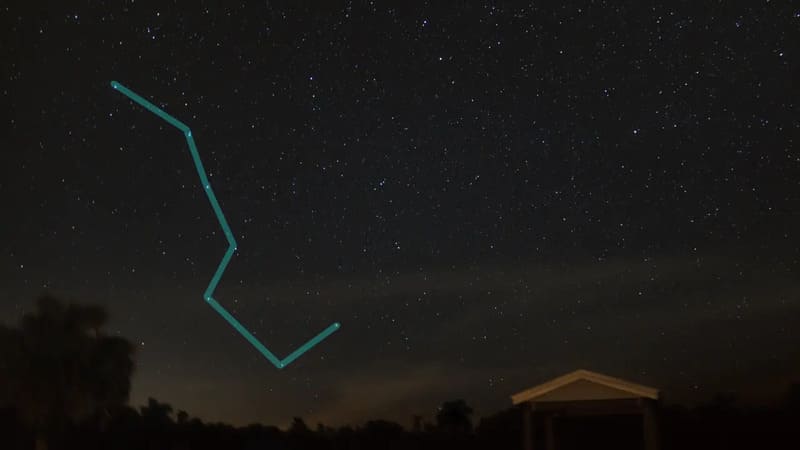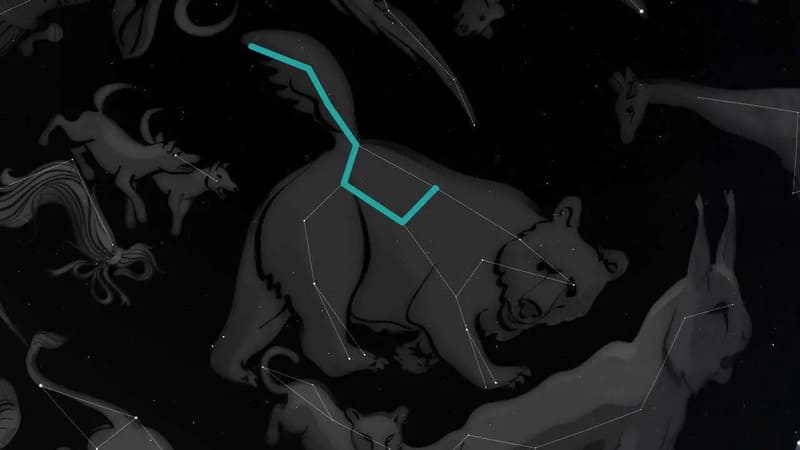Have you ever found yourself gazing at the night sky, wondering, “Why is the Big Dipper upside down?” This intriguing phenomenon has captivated astronomers and stargazers for centuries, leaving them pondering the mysteries behind its curious orientation.
This article explores the scientific reasons behind the Big Dipper’s upside-down appearance. It delves into the concepts of circumpolar constellations, Earth’s tilted axis, and the effect of latitude, providing fascinating insights into this celestial phenomenon.
In a nutshell:
- The Upside-Down Appearance: The Big Dipper asterism appears upside down because of Earth’s rotation and position in the sky, causing its orientation to change throughout the night and from season to season.
- Circumpolar Constellations: Circumpolar constellations, like the Big Dipper, remain in the same position in the sky and are visible year-round from specific locations, as they are located near the celestial pole.
- The Role of Earth’s Tilted Axis and Latitude: The Big Dipper’s orientation varies depending on an observer’s latitude. At higher latitudes, the Dipper can appear upside down due to the perspective of viewing it from the other side of the North Pole.
In this article, you get to
Understand why the Big Dipper appears upside down from Earth’s perspective.
Learn about the distinct shape and features of the Big Dipper constellation, also known as the Plough.
Discover how Earth’s rotation and the position of the Big Dipper in the sky contribute to its changing orientation.
Explore the concept of circumpolar constellations and why the Big Dipper is considered one.
Gain insights into how an observer’s latitude affects the appearance of the Big Dipper in the night sky.
Learn about the significance of Earth’s tilted axis and its impact on the orientation of celestial objects.
Discover the historical and cultural significance of the Big Dipper in different civilizations and mythologies.
Learn about the scientific method used to identify constellations, including the Big Dipper.
Explore the tools and technologies used by astronomers to observe and study constellations.
Gain an understanding of the role of star patterns in identifying constellations and mapping their positions in the sky.
Discover the significance of the Big Dipper in various cultures and its role as a navigational tool, celestial clock, and symbol.
Learn about frequently asked questions and misconceptions surrounding the Big Dipper’s upside-down appearance.
By the end of this article, you’ll have all the info you ever needed about the Big Dipper’s orientation in the night sky.
Let’s dive right in.
Recommended For You
Why is the Big Dipper upside down?

Have you ever been stargazing and noticed that the Big Dipper appears to be upside down?
This curious phenomenon has puzzled astronomers and stargazers alike for centuries. In this article, we’ll explore the science behind the Big Dipper’s orientation and why it appears upside down from Earth’s perspective.
But first, let’s take a closer look at this famous constellation. The Big Dipper, also known as the Plough, is one of the most recognizable constellations in the northern hemisphere. It is made up of seven stars, which form a spoon-shaped pattern. The two stars on the end of the bowl of the spoon point towards the North Star, making it a helpful tool for navigation.
Understanding the Big Dipper’s orientation

The Big Dipper is a well-known constellation easily recognizable by its distinct shape. However, one peculiar feature of the Big Dipper that often raises questions is its upside-down appearance to observers on Earth.
So why does the Big Dipper appear upside down?
The key to understanding the Big Dipper’s orientation lies in its position relative to Earth’s perspective. The Big Dipper is a circumpolar constellation, which means it never sets below the horizon and is always visible in the northern sky.
As the Earth rotates on its tilted axis, different parts of the sky come into view at different times of the night and year.
As a result, the apparent position of the Big Dipper changes throughout the night and from season to season. During some parts of the year, the Big Dipper may appear upright in the sky, while during other times, it may appear upside down or at an angle.
It’s important to note that the orientation of the Big Dipper may also vary depending on an observer’s latitude. The closer an observer is to the North Pole, the higher the Big Dipper will appear in the sky, and the less likely it is to appear upside down.
While the upside-down appearance of the Big Dipper may seem curious, it is simply a result of the complex interplay between Earth’s rotation, the position of the constellation in the sky, and the observer’s location on the planet.
Understanding the basic mechanics behind the Big Dipper’s orientation can help observers appreciate its beauty and better navigate the night sky.
The concept of circumpolar constellations

Have you ever noticed that some constellations appear to move across the sky while others remain stationary? This is because of the Earth’s rotation and its orientation in relation to the celestial sphere.
The celestial sphere is an imaginary sphere surrounding the Earth, and all celestial objects appear on its surface. As the Earth rotates on its axis, the celestial sphere appears to rotate around us, causing the stars and constellations to appear to move across the sky.
Circumpolar constellations are unique because they appear to remain in the same position in the sky without noticeable movement. This is because they are located near the north celestial pole, the point in the sky directly above the Earth’s north pole.
From the perspective of an observer at the Earth’s equator, the celestial pole appears to be on the horizon, and circumpolar constellations cannot be seen. However, as an observer moves closer to the Earth’s poles, the altitude of the celestial pole increases and more circumpolar constellations become visible.
The Big Dipper and the Little Dipper are circumpolar constellations, which means they are visible year-round from certain locations on Earth, including North America. However, their appearance may differ depending on an observer’s latitude.
FREE STARGAZING CHECKLIST
My 5-page Stargazing Checklist will enhance your astronomical observations.
Follow this free checklist to navigate the night sky with confidence, clarity, and a sense of preparedness for a rewarding stargazing experience.

The tilted axis of Earth

One of the main reasons for the Big Dipper appearing upside down is Earth’s tilted axis. Earth has a tilted axis of approximately 23.5 degrees, which causes the orientation of celestial objects to change, as seen from different latitudes on Earth.
As Earth rotates on its axis, the orientation of the Big Dipper appears to change.
From the perspective of observers near the equator, the Big Dipper appears right-side up.
However, as one moves further north, the orientation of the Big Dipper begins to appear tilted and, eventually, upside down.
The tilt of the Earth’s axis also causes the position of the Big Dipper to change throughout the night. As Earth rotates, the Big Dipper appears to move across the sky, eventually disappearing below the horizon.
The concept of Earth’s tilted axis is essential to understanding celestial objects’ behavior and apparent motion in the night sky. It is also a primary factor contributing to the Big Dipper’s upside-down appearance.
The Effect of Latitude on the Big Dipper
Have you ever noticed that the Big Dipper appears upside down at certain times? This phenomenon can be observed in the night sky by those at higher latitudes, such as Canada.
The reason for this upside-down effect is due to the observer’s perspective. Depending on an observer’s latitude, celestial objects, including the Big Dipper, can appear to rotate around the North Star at different angles. This means that the orientation of the Big Dipper can appear to be flipped as if it were standing on its handle instead of resting on its bowl.
For example, at the equator, the Big Dipper appears on its side, perpendicular to the horizon. However, as an observer moves further north, the Dipper begins to tilt and eventually appears upside down. This is because the observer now sees the Dipper from the other side of the North Pole.
It’s important to note that the latitude effect on the Big Dipper is not unique to this constellation. All celestial objects can appear differently depending on the observer’s location on the Earth’s surface.
The Historical and Cultural Significance of the Big Dipper

The Big Dipper, also known as the Plough, has been a prominent fixture in the night sky for centuries. Its distinctive shape has led to its use in various cultures and mythologies as a navigational tool, celestial clock, and spiritual guide.
The Big Dipper is part of the Ursa Major constellation.
In Native American cultures, the Big Dipper was revered as the Great Bear, and its position in the sky was believed to hold great significance in predicting seasonal changes and guiding hunting expeditions. The seven stars of the Big Dipper were also seen as seven hunters chasing the Big Bear across the sky.
Similarly, in Chinese folklore, the Big Dipper is known as the Seven Mansions. The Big Dipper stars were associated with the Taoist concept of the Heavenly Market, where the fates of mortals were decided based on their deeds on Earth. The Dipper was seen as a gateway to the afterlife and was often used in funeral ceremonies.
The Big Dipper has also played a significant role in European culture. In ancient Greece, the constellation was called the Bear Wagon, and the stars represented the nymph Callisto and her son Arcas, who were transformed into bears by Zeus. In Norse mythology, the constellation was known as Thor’s Wagon, and the stars were associated with the god Thor and his chariot.
Today, the Big Dipper remains a popular symbol in various fields, from astronomy to pop culture. Its unique shape and cultural significance make it a fascinating subject for stargazers and scholars alike.
The scientific method behind identifying constellations

Identifying constellations, including the Big Dipper, involves following a specific scientific method. First, astronomers determine a constellation’s boundaries based on its stars’ positions and brightness. Next, they assign a name and symbol to the constellation based on its perceived shape and mythology.
The International Astronomical Union (IAU) oversees the standardization and nomenclature of constellations. According to the IAU, there are 88 modern constellations recognized worldwide.
Constellations are categorized based on their location in the sky, with some being visible all year round, while others are only visible during certain seasons. The Big Dipper, for example, is a circumpolar constellation in the northern hemisphere, meaning it never dips below the horizon and can be observed year-round.
The significance of star patterns
The scientific method of identifying constellations relies heavily on recognizing star patterns. Stars within a constellation are often not physically related but appear close together from Earth’s perspective.
Identifying star patterns involves observing and mapping the positions of stars in the sky, along with their distances from one another. Computer software and telescopes aid in this process, providing astronomers with detailed images of stars and other celestial objects.
The study of constellations has been ongoing for centuries and continually evolves as technology and discoveries enhance our understanding of the universe.
The Tools and Technology for Observing Constellations
Studying the stars and constellations has been a human endeavor for centuries, and we have come a long way since our ancestors first gazed up at the night sky. Modern astronomers can access the most advanced equipment and technology for observing and studying celestial objects.
One of the most powerful tools for observing constellations is the telescope. Telescopes allow astronomers to see faint and distant objects invisible to the naked eye. They can also capture detailed images of celestial objects, which can be analyzed to learn more about their composition, structure, and behavior.
In addition to telescopes, astronomers use various other tools and technologies to study constellations. Some of these include:
- Spectrometers: These instruments allow astronomers to analyze the light emitted by a celestial object, revealing its composition and other properties.
- Photometers: These devices measure the brightness of a celestial object, which can be used to study changes in its behavior over time.
- Radio telescopes: These instruments detect radio waves emitted by celestial objects, which can reveal information about their structure and behavior.
- Computer models: Astronomers can use sophisticated computer models to simulate celestial objects’ behavior, helping them better understand their properties and behavior.
Combined with these instruments’ vast amounts of data, astronomers can learn about constellations such as the Big Dipper. By analyzing the light and other properties of these celestial objects, astronomers can learn about their composition, structure, and behavior, shedding light on the mysteries of our universe.
The powerful tools and technologies available to modern astronomers allow them to study and understand the mysteries of the universe. So, how far away is the Big Dipper?
Frequently Asked Questions (FAQs) About the Big Dipper’s Orientation
Even with the detailed explanations in the previous sections, there are still some common questions and misconceptions surrounding the upside-down appearance of the Big Dipper. Here are some of the frequently asked questions:
Why does the Big Dipper appear upside down?
As explained earlier, the orientation of the Big Dipper depends on the observer’s location on Earth. For observers in the Northern Hemisphere, the Dipper appears to be hanging upside down because of the angle at which they view it.
Can the Big Dipper ever appear right side up to observers in the Southern Hemisphere?
No, the Big Dipper is considered a circumpolar constellation, meaning it never dips below the horizon and can only be seen in the Northern Hemisphere. Observers in the Southern Hemisphere can see constellations like the Southern Cross, similar to the Big Dipper’s shape and significance.
Is the Big Dipper a constellation?
Yes, the Big Dipper is a part of the constellation Ursa Major, which translates to “Great Bear” in Latin. The seven stars that make up the Dipper are the most recognizable and significant part of the Ursa Major constellation.
What is the significance of the Big Dipper in different cultures?
The Big Dipper has been significant in various cultures throughout history. In many Native American traditions, the Dipper is seen as a bear or a hunter. In Chinese mythology, the Dipper is known as the “Seven Mansions” and is considered where the heavenly emperor resides. The Dipper has also been significant in European and African cultures as a navigational tool and symbol of the changing seasons.
Can I see the Big Dipper all year round?
Yes, for observers in the Northern Hemisphere, the Big Dipper is visible all year round. Because it is a circumpolar constellation, it never sets below the horizon. However, its orientation will change depending on the time of year and the observer’s latitude.
What tools do astronomers use to study the Big Dipper?
Astronomers use various tools and technology to study and observe the Big Dipper, including telescopes, spectrographs, and imaging equipment. They also use computer programs to track the movements and positions of the stars in the Dipper over time.
Summary: Big Dipper Upside Down
Thank you for reading my article “Why is the Big Dipper upside down?”
Throughout this enlightening article, you have gained a deeper understanding of the fascinating science behind the upside-down appearance of the Big Dipper. By exploring Earth’s tilted axis and the observer’s perspective, you have uncovered the intricate interplay of factors contributing to this captivating phenomenon. You have come to appreciate how the position of the Big Dipper relative to Earth’s rotation and the observer’s location on the planet gives rise to its ever-changing orientation in the night sky.
Moreover, this article has shed light on the Big Dipper’s rich historical and cultural significance. From ancient civilizations to modern societies, this celestial formation has played a prominent role in human history, mythology, and navigation.
You have discovered how diverse cultures have revered the Big Dipper as a symbol of guidance, a celestial clock, and even a spiritual guide.
Native American traditions recognized the Dipper as the Great Bear, influencing seasonal predictions and hunting expeditions.
In Chinese folklore, it held a place as the “Seven Mansions,” associated with the heavenly realm and afterlife.
And in ancient Greece and Norse mythology, the constellation’s stars were linked to mythical tales of transformation and divine chariots.
By exploring these captivating concepts, you have embarked on a thought-provoking journey that expands your appreciation for the wonders of the night sky. From the scientific intricacies of celestial mechanics to the profound symbolism and cultural significance of the Big Dipper, you have gained a newfound perspective on our place in the universe. It serves as a reminder of the universal human fascination with the cosmos and our eternal quest to unravel its mysteries.
As you gaze upon the night sky, you are encouraged to embrace a sense of wonder, seek inspiration from the celestial wonders above, and let your dreams reach for the stars.
Happy Stargazing!




